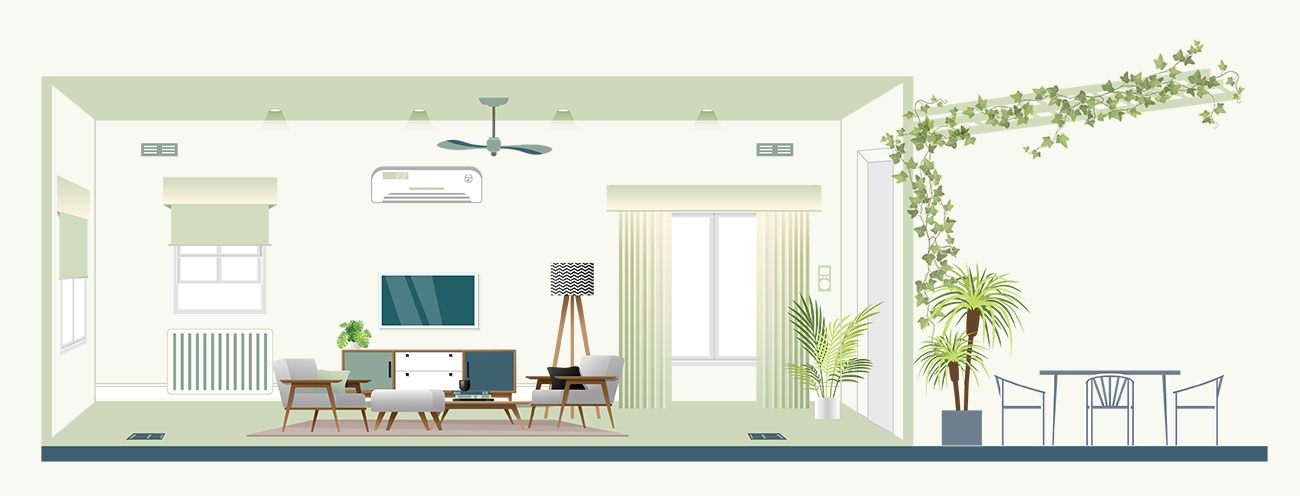Heating and Cooling

 Reverse Cycle AC
Reverse Cycle AC Reverse cycle air conditioner
Reverse Cycle AC's are super efficient and can provide both heating and cooling. Learn how to maintain your AC filter for maximum efficiency.
 Design
Design Comfort by design
Insulation acts like a tea cosy for your home, allowing you to reduce your reliance on active heating and cooling. Most older Victorian homes are not insulated appropriately, are draughty and may have other design issues. Design improvements can go a long way to a more comfortable home.
 Ceiling Fans
Ceiling Fans Ceiling fans
Pedestal and/or ceiling fans offer a great way of moving air around and increasing comfort for minimal cost.
Fans are very cheap to run at only around 2 cents per hour, and can improve comfort levels so you feel about 3°C cooler. In winter mode they can also help stop warm air from rising to the ceiling, making you feel warmer.
 Ducting
Ducting Ducted heating & cooling
Central heating and cooling systems can facilitate consistent temperatures throughout the home. However there are numerous downsides to this approach. Energy is used to heat or cool unoccupied rooms, and the ducting itself is inefficient.
 Hydronic Heating
Hydronic Heating Hydronic heating
Common in many parts of the world (particularly the northern hemisphere), hydronic heating is highly regarded as it provides comfortable, radiant heat distributed through water in pipes. Hydronic heating systems are significantly more expensive to install than reverse cycle AC units. Operating costs can also add up as boilers are commonly operated for long periods to counteract system inertia.
 Behaviour Changes
Behaviour Changes Behaviour changes
Regardless of the heating and cooling technology installed, the way it is operated can have a significant effect. A single degree up or down on the thermostat can impact energy consumption by as much as 10%.
As a guide, cooling temperatures should be set at 23-25°C and heating should be set to 18-20°C.
 External shading
External shading External shading
Well designed external shading including pergolas, eaves and deciduous plants, will help your home feel cooler without needing to switch on your AC.
 Cross Breezes
Cross Breezes Passive cooling
Harness prevailing breezes to cool the home during warmer months without switching on your AC.
 Windows & Doors
Windows & Doors Windows and blinds
Window and door glazing, frames, draught proofing, as well as curtains and blinds have a great impact on your thermal comfort, reducing the need for active heating and cooling such as air conditioners.
Heating and cooling typically account for the largest energy demand in the average Australian home, combining to contribute around 40% of total consumption. A correctly sized system will save you energy and money - too large will use unnecessary energy and too small will struggle to keep up.
Reverse cycle air conditioners (RCAC)
Cooling-only units (including evaporative) don’t make a lot of sense these days given the efficiency and competitive pricing of reverse-cycle air conditioners (RCACs), which provide both heating AND cooling. An additional concern with evaporative cooling is the water use, which can be extreme on a hot day, up to 10 times Victoria’s recommended daily water consumption per person.
In fact, RCACs (also known as split systems) are now acknowledged as the cheapest form of home heating, due to the highly efficient heat pump technology they employ. Heat pumps use refrigerants to collect free, renewable heat energy from the outside air (even below freezing) and can amplify heat output to 4-5 times the energy they consume. RCACs are about a third the cost of heating with gas and less than a quarter compared to electric resistive heaters.
Design
Passive design delivers comfort by harnessing favourable climatic conditions, retaining or expelling heat from a building as needed. A well designed building incorporating passive features will feel cooler in summer and warmer in winter, reducing the need for (and cost of) air conditioning. Particularly relevant for new builds and renovations, passive design features to consider include:
Orientation. Position of the home on site can have a big impact on thermal performance, designed so that sunlight is welcomed into interior spaces as seasonally required.
Passive heating. Maximising solar penetration into the building during winter months reduces the need for additional heating.
Thermal mass. A heat-absorbing mass (e.g concrete, stone or brick floors) can help moderate internal temperatures by absorbing sunlight or heat from a fire. However, this can also be counterproductive by preventing the home from cooling on a hot day, so it's important to insulate underneath and around the sides.
Passive cooling. Harness prevailing breezes to cool the home during warmer months. Consider external blinds and deciduous plantings which will provide shade during summer but allow sunlight to enter the home in winter. Find out more in our External Shading section.
Climate. Design for maximum heat gain in colder areas; invite the sun inside to passively warm the home during cooler months. In hot areas, it is prudent to provide shade wherever possible.
Insulation. Like a tea cosy for your home, insulation is helpful in both warm and cool climates. Find out more in our Insulation & Draught Proofing section.
Window treatments. Effective at preventing energy transfer through windows, window treatments are relatively simple to implement. Consider heavy thermally lined drapes, curtains, pelmets, honeycomb blinds. Find out more in our Windows & Doors section.
Glazing. Susceptible to variations in temperature, windows should be thermally broken and (at least) double glazed to help facilitate consistent indoor temperature. Retrofit double glazing and even bubble wrap can be effective. Find out more in our Window Glazing section.
Skylights. Generally speaking, it is better to consider an LED panel, strip or bulb for adding light to dark interior spaces. If you must add a skylight, ensure it is double (or triple) glazed to minimise heat transfer.
Condensation. As homes become more airtight, ventilation and moisture management are increasingly important, particularly if mould is an issue. Heat Recovery Ventilation (HRV) systems can assist, along with opening windows for fresh air. Find out more in our Moisture Management section.
Energy source
Heating
Historically wood, gas and other combustible fuels have been common heating tools; however in recent decades it has become abundantly clear these are unsustainable for people and the planet. Electric heat pump technology has changed the landscape from an efficiency point of view, particularly for heating. The efficiency benefit of reverse cycle air conditioners is available to all homes - for those fortunate enough to have solar panels, the benefit is magnified further.
Cooling
Start with passive cooling, typically through harnessing natural air flows and insulation from outdoor air temperatures. Pedestal and/or ceiling fans offer a great way of moving air around and increasing comfort for minimal cost. Split system air conditioning is often the next step thanks to very good efficiency - particularly in fan-only mode - and the welcome injection of cool air. Evaporative cooling has been popular in the past but has now been well and truly surpassed by heat pump technology, which has the added advantage of heating as well.
Ducting
Many Australian homes incorporate central heating and cooling systems to facilitate consistent temperatures throughout the building. There can be no doubt that while this provides a level of comfort from room to room, there are several downsides to this approach. First and foremost is the energy required to heat or cool unoccupied rooms, which can be mitigated by zoning the system to heat/cool only certain areas, rather than the whole house.
Another issue is the efficiency of the ducting itself, meaning air delivered far from the source will shed some of its energy en route.
Hydronics
Common in many parts of the world (particularly the northern hemisphere), hydronic heating is highly regarded as it provides comfortable, radiant heat distributed through water in pipes. The closed, pressurised system radiates heat via wall panels or the thermal mass of a concrete slab. While luxurious and moderately efficient (provided pipes are insulated), hydronic heating systems are significantly more expensive to install than RCAC units, and are not typically used for cooling (although have some capacity for this if driven by a heat pump). Operating costs can add up as boilers are commonly operated for long periods (sometimes months) to counteract system inertia.
Behaviour
Regardless of the heating and cooling technology installed, the way it is operated can have a significant effect. A single degree up or down on the thermostat can impact energy consumption by as much as 10%. As a guide, cooling temperatures should be set at 23-25°C and heating should be set to 18-20°C, making adjustments to clothing as required to remain comfortable.
Switching off lights and other appliances when not in use, as well as using timers as appropriate can help further reduce energy consumption. Portable blow heaters are generally very inefficient and should be used sparingly; alternatives worth considering include electric blankets, foot warmers, hot water bottles and extra clothing to provide additional warmth.
